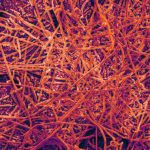Link to Pubmed [PMID] – 34929015
Link to DOI – 10.1371/journal.ppat.1010173
PLoS Pathog 2021 Dec; 17(12): e1010173
For many intracellular bacterial pathogens manipulating host cell survival is essential for maintaining their replicative niche, and is a common strategy used to promote infection. The bacterial pathogen Listeria monocytogenes is well known to hijack host machinery for its own benefit, such as targeting the host histone H3 for modification by SIRT2. However, by what means this modification benefits infection, as well as the molecular players involved, were unknown. Here we show that SIRT2 activity supports Listeria intracellular survival by maintaining genome integrity and host cell viability. This protective effect is dependent on H3K18 deacetylation, which safeguards the host genome by counteracting infection-induced DNA damage. Mechanistically, infection causes SIRT2 to interact with the nucleic acid binding protein TDP-43 and localise to genomic R-loops, where H3K18 deacetylation occurs. This work highlights novel functions of TDP-43 and R-loops during bacterial infection and identifies the mechanism through which L. monocytogenes co-opts SIRT2 to allow efficient infection.


